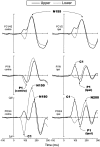Cortical sources of the early components of the visual evoked potential
- PMID: 11835601
- PMCID: PMC6871868
- DOI: 10.1002/hbm.10010
Cortical sources of the early components of the visual evoked potential
Abstract
This study aimed to characterize the neural generators of the early components of the visual evoked potential (VEP) to isoluminant checkerboard stimuli. Multichannel scalp recordings, retinotopic mapping and dipole modeling techniques were used to estimate the locations of the cortical sources giving rise to the early C1, P1, and N1 components. Dipole locations were matched to anatomical brain regions visualized in structural magnetic resonance imaging (MRI) and to functional MRI (fMRI) activations elicited by the same stimuli. These converging methods confirmed previous reports that the C1 component (onset latency 55 msec; peak latency 90-92 msec) was generated in the primary visual area (striate cortex; area 17). The early phase of the P1 component (onset latency 72-80 msec; peak latency 98-110 msec) was localized to sources in dorsal extrastriate cortex of the middle occipital gyrus, while the late phase of the P1 component (onset latency 110-120 msec; peak latency 136-146 msec) was localized to ventral extrastriate cortex of the fusiform gyrus. Among the N1 subcomponents, the posterior N150 could be accounted for by the same dipolar source as the early P1, while the anterior N155 was localized to a deep source in the parietal lobe. These findings clarify the anatomical origin of these VEP components, which have been studied extensively in relation to visual-perceptual processes.
Copyright 2001 Wiley-Liss, Inc.
Figures











References
-
- Aine CJ, Supek S, George JS (1995): Temporal dynamics of visual‐evoked neuromagnetic sources: effects of stimulus parameters and selective attention. Int J Neurosci 80: 79–104. - PubMed
-
- Aine CJ, Supek S, George JS, Ranken D, Lewine J, Sanders J, Best E, Tiee W, Flynn ER, Wood CC (1996): Retinotopic organization of human visual cortex: departures from the classical model. Cereb Cortex 6: 354–361. - PubMed
-
- Biersdorf WR (1974): Cortical evoked responses from stimulation of various regions of the visual field. Doc Ophthalmol Proc 3: 247–259.
-
- Bodis‐Wollner I, Brannan JR, Nicoll J, Frkovic S, Mylin LH (1992): A short latency cortical component of the foveal VEP is revealed by hemifield stimulation. Electroencephalogr Clin Neurophysiol 84: 201–208. - PubMed
MeSH terms
LinkOut - more resources
Full Text Sources

